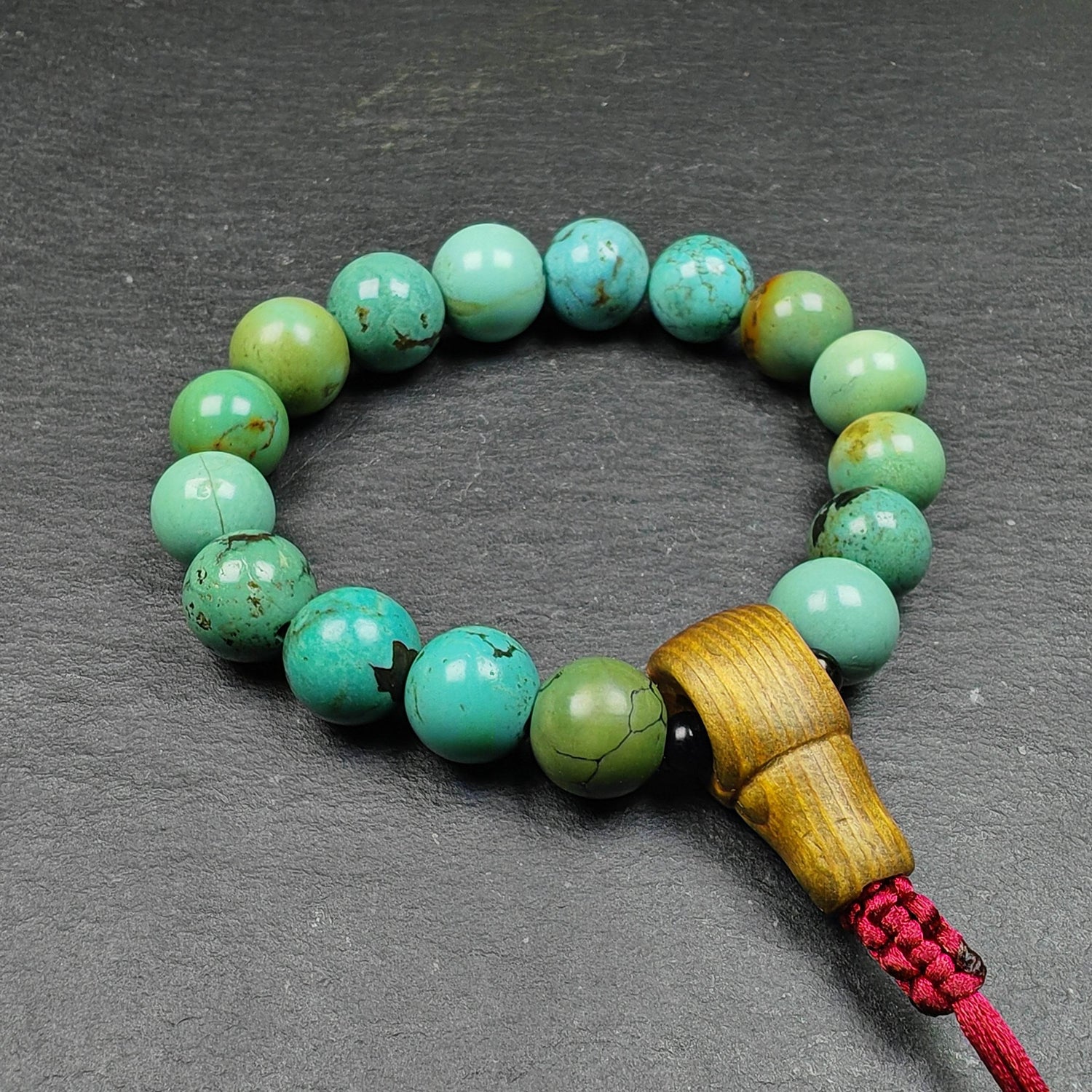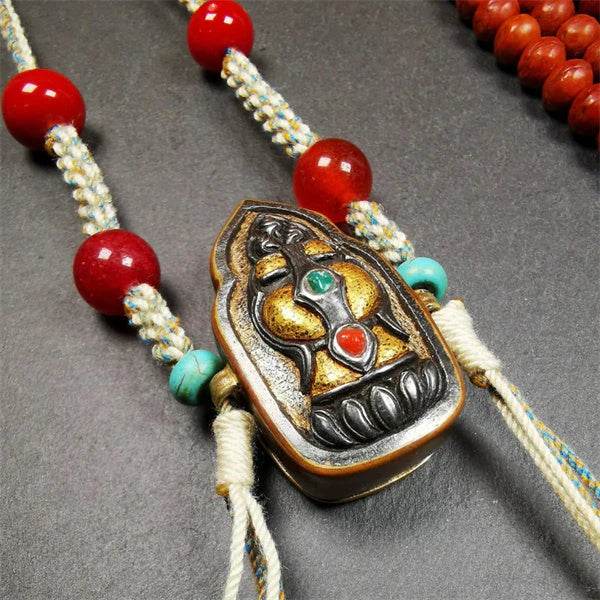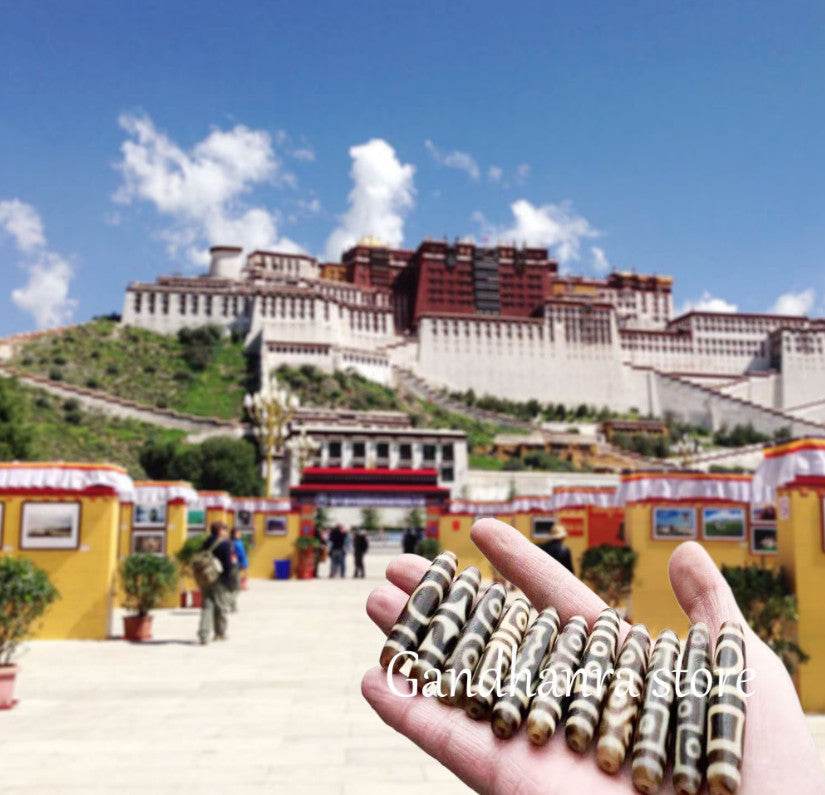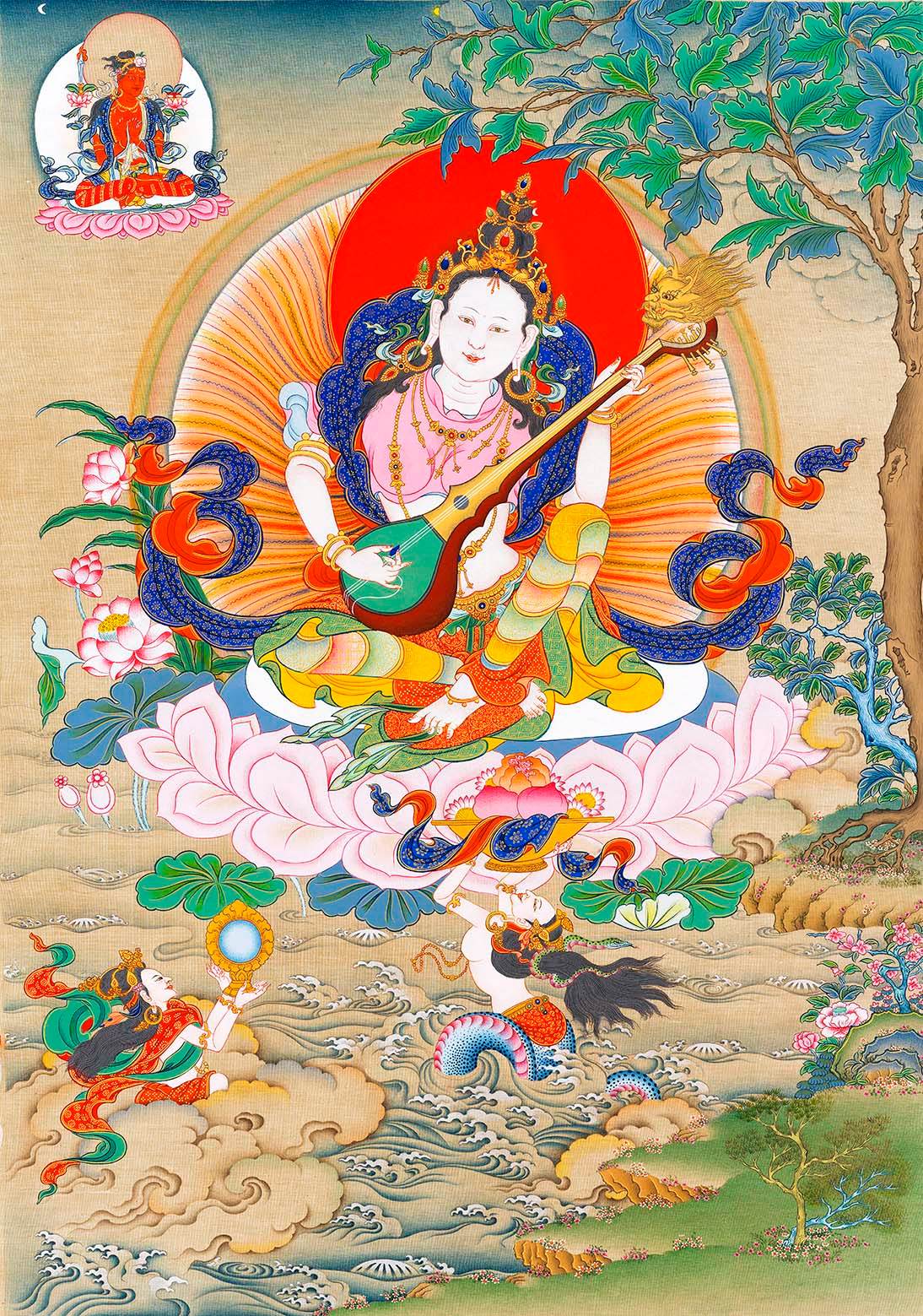
From the Battle for the Relics ▎Swayambhunath

Swayambhu Stupa
ཨེ་མ་ཧོ།
རང་བྱུང་ཆོས་སྐུའི་མཆོད་སྡོང་ཆེན་པོ་ནི། །
རྒྱལ་བ་རྣམས་ཀྱི་ཐུགས་ཀྱིས་བྱིན་བརླབས་ཤིང་། །
རྡོ་རྗེའི་ཟོམ་ཞེས་གྲགས་པ་ཆེན་པོ་དེར། །
ངོ་མཚར་བསམ་མི་ཁྱབ་ལ་གསོལ་བ་འདེབས། །
ཤཱནྟ་པུ་རིའི་གྲོང་ཁྱེར་ས་སྤྱོད་ཞིང་། །
ཧེ་རུ་ཀ་ཡི་སྤྲུལ་པའི་དཀྱིལ་འཁོར་བཞུགས། །
འཕགས་པ་ཤིང་ཀུན་གཟུགས་སྐུའི་མཆོད་སྡོང་ཆེ། །
གོ་མ་ས་ལ་གནྡྷར་གསོལ་བ་འདེབས། །
......
ཅེས་པའང་ཆོས་ཀྱི་བློ་གྲོས་པས་
རྟེན་མཆོག་ཉིད་ཀྱི་དྲུང་དུ་གསོལ་བ་བཏབ་པའོ།། །།
Ema Ho!
The self-arisen Dharmakaya Stupa,
Blessed by the wisdom mind of all Buddhas,
Arrived at the place renowned as "Vajra Peak,"
Manifesting countless unimaginable wonders—I pray with devotion.
In the earthly town of Santi Pur,
Stands the mandala of Heruka’s emanation,
The glorious Swayambhu Nirmanakaya Stupa,
To Gomashara Ganda, I offer my prayers!
...
Thus, Chökyi Lodrö made this aspiration before the sacred stupa.

Portrait of the Swayambhu Stupa
Self-manifested from the Lotus
In prehistoric times, Nepal was once a vast lake that drew many great sages. Vipaśyin, one of the past Seven Buddhas, journeyed there on pilgrimage and cast a seed into its waters. Later, a radiant lotus blossomed upon the lake, and within it self-arose (svayam abhūt samutpannah) a luminous crystal stupa (Sphaṭikamaya caitya) in the form of pure light (Jyotirūpa).
It is revered as the abode of the Victorious Ones (Jinālaya),
The very foundation of the Five Tathāgatas’ essence (Pañcatathāgataśraya),
The support of enlightenment’s sublime virtues (Sambodhiśrīguṇādhāra),
Adorned with all the marks of a Buddha (Sarvalakṣaṇamaṇḍita),
Bearing all that is auspicious (Sarvaśubhārthabhṛt)
And the jewel of the true Dharma (Saddharmaratnabhṛt).

Svayambhu Purana
The above passage is excerpted from the Newar Buddhist scripture Svayambhū Purāṇa, which recounts the mythical origins of the Svayambhū Mahāchaitya (the Great Stupa of Svayambhū). The stupa is called "Svayambhū" (from the Sanskrit for "self-manifested" or "self-originated") because it arose spontaneously from a lotus.
This luminous stupa, composed of crystal, serves as the foundation of the Five Dhyani Buddhas. Its radiant light is said to consist of five colored rays—white, blue, yellow, red, and green—each corresponding to the distinct qualities of the respective Buddhas.

Born from the lotus, the crystal stupa radiates five-colored light.
Today, the Svayambhū Stupa stands in the Kathmandu Valley at the southern foothills of the Himalayas, forming the sacred heart of Swayambhunath Temple. This iconic stupa is instantly recognizable by the four pairs of "All-Seeing Eyes of the Buddha" gazing with wisdom and compassion from each cardinal direction, symbolizing the omniscience of the Primordial Buddha (Ādi-Buddha).
Between each pair of eyes, a curly symbol resembling a nose is actually the Nepalese numeral "1" (एक), representing the unity of all existence. Above the eyes, a third eye is depicted—when the Buddha teaches the Dharma, radiant light emanates from this eye, carrying teachings to celestial realms and inviting deities to descend and listen. For beings in the three lower realms unable to hear the Dharma directly, this light alleviates their suffering.
The stupa's crown consists of thirteen tiered umbrellas (chattras), representing the thirteen stages of spiritual practice that sentient beings must traverse to attain enlightenment.

Swayambhu Stupa
As one of Nepal's oldest and most sacred temples, Swayambhunath has served since ancient times as a pilgrimage center for diverse ethnic groups across the Himalayan region. It stands as a spiritual icon jointly venerated by Newar Buddhism, Tibetan Buddhism, Brahmanism, and even Bon religion. Furthermore, Swayambhunath represents a quintessential "heterotopia" among sacred spaces.
The concept of "Hétérotopie" (Heterotopia) was introduced by the renowned French postmodern philosopher Michel Foucault in his lecture Of Other Spaces (Des espaces autres). Foucault defined heterotopias as real-world spaces shaped by social practices - in contrast to fictional, idealized "utopias." As Foucault observed, "There is no culture in the world that does not constitute heterotopias." Today, this framework has been widely applied in architecture, sociology, and literary studies. This paper will examine the sacred space of Swayambhunath as a case study, exploring how different cultures, communities, and historical periods have constructed, maintained, and continuously transformed the spatial order of this heterotopia.

Michel Foucault (1926-1984)
The Battle for the Sacred Relics
Foucault observed that heterotopias always function in varying modes across different historical epochs. Using Western cemeteries as an example, he noted that while they have consistently served as burial grounds, their purpose has evolved—from medieval corpse disposal to modern memorialization that consoles the living—reflecting broader sociocultural transformations. Swayambhunath follows this paradigm: though perpetually a sacred site, its operational logic has continually adapted to shifting societal needs. Thus, truly understanding Swayambhunath requires examining its dynamic interconnections with the surrounding sociohistorical context.

The Heterotopian moment
Setting aside for now the mythical origins described in the Svayambhū Purāṇa, the earliest extant historical record—the Gopālarājavaṃśāvalī (14th century)—dates the Svayambhū Stupa's construction to the early 5th century CE under King Viśvadeva of the Licchavi dynasty. However, as this chronicle was compiled nearly a millennium after the purported events, the veracity of its account remains subject to scholarly scrutiny.

A Licchavi-period stele discovered near the Svayambhu Stupa
Alexander von Rospatt, one of the foremost scholars on Swayambhunath studies, posits that the construction account in the Gopālarājavaṃśāvalī likely refers to renovations of a pre-existing structure—similar to the eleven documented renovations between 1370 and 1817. In contrast, John C. Huntington has compared its architectural style with ancient Indian stupas, suggesting its original construction might date back to the pre-Christian era. This hypothesis finds support in local Swayambhu traditions claiming Emperor Aśoka's visit to the stupa in the 3rd century BCE.

Comparative Dimensions of the Swayambhu Stupa and Ancient Indian Stupas
Thus, two millennia ago, when the Kathmandu Valley remained within the sphere of ancient Indian influence, Swayambhu likely already existed as a sacred site. Judging by contemporaneous Indian stupas (or relic stupas), the original function of the Swayambhu Stupa was probably to enshrine the Buddha's relics. In early Indian Buddhist culture, the significance of the Buddha's relics manifested in two key aspects: Religiously, the relics not only symbolized the physical presence of Śākyamuni Buddha but also embodied the essence of the Dharma; Politically, they were regarded as potent and auspicious talismans—an influence that persists to this day. It was for these reasons that following the parinirvāṇa of Śākyamuni Buddha, a monumental "War of the Relics" erupted across India.

Relics of Śākyamuni Buddha, housed in the National Museum of New Delhi
The Buddhacarita records this event: "Eight kings raised eight stupas—for the golden urn, the ashes, and the embers. Thus in Jambudvīpa began the Ten Stupas." This passage reveals the armed conflict among eight ancient Indian clans vying for the Buddha's relics. Ultimately, through the mediation of the Brahmin Droṇa, the relics were equally distributed among the eight princes. Each carried them back to their respective tribes to construct relic stupas—these became the famed "Eight Droṇa Stupas" (Droṇastūpa).

Droṇa's Equitable Distribution of the Relics
Emperor Aśoka's Pilgrimage
Later, Emperor Aśoka (r. 273-232 BCE) became renowned for redistributing Śākyamuni Buddha's relics from the Eight Droṇa Stupas into 84,000 Dharmarājika stupas. Historian John S. Strong analyzes this historic event as comprising two critical phases: first, the gathering of the relics, followed by their systematic redistribution across the empire. Given the Mauryan Empire's militant history under Magadha's hegemony, Aśoka's relic collection campaign undoubtedly carried military implications.

King Aśoka Transporting Relics on War Elephants – Depicted in Sanchi Stupa Reliefs
The Ashokavadana records this process: "Aśoka, intent on widely disseminating the Buddha's relics, marched with his fourfold army to the stupa built by King Ajātaśatru. He dismantled the stupa, extracted the relics, and after retaining a portion, erected a new stupa. This procedure was repeated at each subsequent stupa—removing relics and establishing new stupas as expressions of his Buddhist devotion."
This reveals that although Aśoka ruled over all of India at the time, local authorities governing these stupas resisted to protect the relics. Among the original Eight Droṇa Stupas, one was located in the ancient Nepalese kingdom of Rāmagāma, known as the Rāmagrāma Stupa. Through comparative analysis of the Ashokavadana, Svayambhū Purāṇa, and Mahāparinibbāna Sutta, John C. Huntington has proposed that the Rāmagrāma Stupa likely served as the precursor to the present-day Swayambhunath Stupa.

The disputed archaeological site of Rāmagrāma Stupa in the Terai Plains
The legend of Emperor Aśoka’s third-century BCE visit to Swayambhunath may indeed be connected to the so-called "War of the Relics." The Ashokavadana records: "After collecting relics from the seventh stupa, Aśoka proceeded to Rāmagrāma. There, the nāgas led him to their palace and declared their devotion to their own stupa (the Rāmagrāma Stupa). Thus, Aśoka permitted them to keep the relics and departed under the personal escort of the Nāga King."
Notably, the Svayambhū Purāṇa identifies the vast prehistoric lake from which the self-arisen stupa emerged as Nāgavāsadaha—"the Lake of the Nāgas." To this day, the Kathmandu Valley remains a center of nāga veneration, further intertwining the mythic and historical threads of this sacred site.

Depiction of Emperor Aśoka's Visit to Rāmagrāma Stupa in the Sanchi Stupa Reliefs
Through his extensive construction of stupas and strategic redistribution of relics, Emperor Aśoka successfully transformed himself into a paramount patron of the Dharma, thereby consolidating both religious and political authority across India. Notably, the inhabitants of the Nāga territory were spared from Aśoka’s military campaigns due to the sacred status of the Rāmagrāma Stupa.
This demonstrates that within early Indian Buddhism, stupas served purposes far beyond merely housing the Buddha’s relics. Crucially, their connection to the relics endowed their patrons with significant discursive power in both spiritual and political realms. In an era of constant warfare, these stupas—by integrating various Buddhist symbolic elements with physical relics—functioned as what might be termed "hétérotopies de crise" (crisis heterotopias), providing war-torn communities with sacred refuge in both metaphysical and material dimensions.

Western Face of the Swayambhu Stupa
Struggle for Discursive Power
In later historical developments, Buddhism migrated from India, reaching China by the 5th century and flourishing in Tibet after its 7th-century introduction from the Central Plains—even as it gradually lost discursive dominance in its homeland. Meanwhile, the Newars established a relatively stable polity in the Kathmandu Valley, developing a distinctive Newar Buddhism from the 15th century onward, marking their entry into a period of social stability.
At this stage, the Newars were no longer content to position Swayambhu within the "outdated" Indian Buddhist framework as merely a regional cult center. Thus began their transformation of this heterotopia, adapting it to function within new sociopolitical realities.

Oil Painting "Swayambhunath Stupa"
Dev Art Gallery
One of the Newars' primary tasks was to recompile the myths of Swayambhu—or rather, to rewrite its history, for history often begins with myth. A seminal achievement in this endeavor was the aforementioned Svayambhū Purāṇa, a text recounting the history of the Swayambhu Valley that fundamentally reshaped the site's religious context and spatial significance.
The Purāṇa deliberately downplayed the veneration of Śākyamuni Buddha's relics, instead introducing the Five Tathāgatas of Vajrayāna tradition and past Buddhas, thereby emphasizing the stupa's "self-arisen sanctity." As previously cited in the Purāṇa, Newar Buddhism posits that this valley was a pilgrimage site for ancient Buddhas as early as the prehistoric lake era—its existence predating the world itself. Thus, the sacredness of Swayambhu Stupa derives not from human intervention or enshrined relics, but from its intrinsic connection to the valley's genius loci (spirit of place).

Painting "Jyotisvarūpa Svayambhū Caitya"
After the self-manifestation of the crystal stupa from the lotus, Mañjuśrī Bodhisattva—residing in China's Wutai Mountain—perceived its radiant light through meditation. Assuming the form of the Vajra Master Mañjudeva, he journeyed to Nepal as a pilgrim. Enchanted by the vision, he cleaved the valley with his sword, draining the lake that covered Nepal, enabling devotees to settle and perpetually venerate the sacred Svayambhū Stupa.
Later, King Pracandadeva of the eastern Indian Gauda Kingdom renounced his throne and came to Kathmandu, where he was consecrated as a Newar Vajrācārya. Foreseeing the advent of the kaliyuga (Age of Decline), he feared the desecration of Svayambhū. Resolving to protect the luminous crystal stupa, he encased it within a robust structure through a two-stage process: first sealing the self-arisen caitya with stone, then constructing a brick stupa over it.

Mañjuśrī cleaves the valley to drain the sacred lake
The passage from the "Book of the Past" reveals that the Swayambhunath Stupa we see today is not the "self-illuminating" crystal stupa itself, but a physical structure built by later generations to protect this sacred entity. The Nepalese redefinition of the sacred entity of the stupa and the application of the physical structure deviate significantly from the traditional image and function of stupas from ancient India. When the "Book of the Past" designates the origin of the newly introduced main object of worship, Manjushri Bodhisattva, as China instead of its traditional homeland of India, it may be aimed at diminishing India's status as a Buddhist center. Depicting the crystal stupa as the foundation of the five Dhyani Buddhas and a pilgrimage site for past Buddhas is clearly intended to shape Kathmandu as the supreme Buddhist cosmocentric center over India and all other Buddhist centers. This practice undoubtedly aligns with the urgent desire of the stable Nepalese regime at the time to wrestle away the discourse of Buddhism from Lumbini and establish a new Buddhist cosmic order at Swayambhunath.
The "Book of the Past" not only reshapes the sacred landscape of Swayambhunath but also to some extent influences the religious landscape of the Himalayan region. Similar narratives are also found in Bon religious traditions. Bon literature mentions that the founder of Yongdzong Bon(གཡུང་དྲུང་བོན་), Shenrab Mipho(གཤེན་རབ་མི་བོ), had visited Swayambhunath before the birth of Gautama Buddha and instructed his disciples to build a statue stupa at the site. This makes Swayambhunath a sacred site for Bon followers, with lineage masters of Bon, including Dzam Namdak Rinpoche(སློབ་དཔོན་བསྟན་འཛིན་རྣམ་དག), having made pilgrimages here.

In 1991, Danze Nanda Rinpoche visited Swayambhunath.
"The Book of the Deceased" has undergone multiple revisions and has multiple versions. The earliest version was written in Sanskrit, and Nepalese scholar Diwakar Acharya speculates that it may have been written in the first half of the 16th century. Subsequent versions began to be written in Nepali, and the Tibetan translation was first completed in the mid-18th century by the renowned Tibetan scholar the 8th Situ Rinpoche (ཆོས་ཀྱི་འབྱུང་གནས།; 1700-1774). This was done in response to a request from the Nyingma monk Khathog Rigdzin Tsewang Norbu (ཀཿཐོག་རིག་འཛིན་ཚེ་དབང་ནོར་བུ།; 1698-1755) during Situ Rinpoche's visit to Nepal in 1748. Situ Rinpoche then used this translation as a basis to write "The Nepal Pilgrimage Guide." It is recorded that he also supervised the restoration of stupas and provided generous funds for the restoration work.

The 8th Situpa Panchen (Chökyi Jungné, 1700-1774)
Solemn forest
In multiple Tibetan translations, the Swyambhunath is referred to by the Tibetans as "འཕགས་པ་ཤིང་ཀུན།" (Sacred Forest), and according to some accounts, "ཤིང་ཀུན།" is phonetically transliterated from the Nepali word "Singgu" (meaning "self-origin"). The Tibetan people have a longstanding reverence for Swyambhunath and seem to have their own "Swyambhunath history." The rediscovered Lotus Teachings from the 13th century narrate another origin story of the Swyambhunath stupa:
"It is said that after Avalokiteshvara Bodhisattva saved sentient beings and found that countless beings were still trapped in the cycle of existence, he felt sorrow and helplessness. Two tears that fell from his eyes turned into two celestial maidens, one of whom was born as the human Dechen Nyima. Dechen Nyima gave birth to four sons with four herders in the human realm, and they accumulated wealth and developed faith in the Dharma, pooling resources to build the Swyambhunath stupa (in some versions, it is called the Buddha Natamaya stupa). After the stupa was built, the four brothers made wishes in front of the stupa. The eldest son wished to be reborn as a king (Chakdze Zangpo), the second son wished to be reborn as a Vajrayana guru (Lotus-born Great Master), the third son wished to be reborn as a monk (Bodhisattva, also known as Jigme Chokyi Wangpo), and the youngest son wished to be reborn as an envoy (Yalong Bame Chiksel). Their karma led Chakdze Zangpo to invite the Lotus-born Great Master to come to Tibet to propagate the Dharma [...]"
In this narrative, the Swyambhunath stupa becomes the crucial medium that prompts the Lotus-born Great Master to travel to Tibet and propagate the Dharma with King Chakdze Zangpo, the abbot Jigme Chokyi Wangpo, and the envoy Yalong Bame Chiksel. In the "Life of the Lotus Master," the Swyambhunath stupa is not built by a king or "self-origin," but is the result of the past karmic connections between the Lotus Master, Jigme Chokyi Wangpo, Tibetan royal officials, serving the construction in service of the "Lotus Master faith" and the construction of the "king-monk-envoy" triad model in the Tibetan region.

Thangka: Avalokiteśvara
Heterotopic Configuration
From an ancient pilgrimage site visited by India's Emperor Aśoka, to the self-manifested "Foundation of All Buddhas," and further to Padmasambhava's karmic connections with Tibetan royalty—Swayambhunath has been successively reimagined across epochs, acquiring new origin myths and religious identities. By continuously reshaping the historical narratives and operational logics of this sacred site, it has fulfilled diverse utopian aspirations for communities undergoing social upheavals, assuaging the existential anxieties wrought by change.
Now, under globalization's tide, this Himalayan sanctuary draws worldwide attention. The influx of Western ideologies reshapes Nepal's nascent democracy, while UNESCO's 1979 World Heritage designation transformed the Kathmandu Valley into a crossroads for global pilgrims, scholars, capitalists, and politicians. As globalism and modernization collide with ancient belief systems, the valley's current sociopolitical metamorphosis may profoundly reconfigure this heterotopia—once again.

West Side of the Stupa upon Completion of Restoration Works (June 2010)
Workers hanging a gilded copper banner inscribed with the honorific title of Darthang Trulku Rinpoche (དར་ཐང་སྤྲུལ་སྐུ་རིན་པོ་ཆེ)
Land of Many Places
Another defining feature of heterotopias is their capacity to juxtapose multiple contradictory or incompatible spaces within a single real place, constructing unique heterogeneous spaces through the creative integration of disparate elements. As Foucault observed, the ancient Persian garden exemplifies this principle: Persian designers sought to create earthly paradises, elongating one axis to form a rectangular layout with four intersecting waterways meeting at a central pool. This quadripartite design symbolically juxtaposed the four elemental components of the world (sky, water, earth, and flora), materializing humanity's yearning to reconstruct Edenic perfection.

Persian Garden
Much like the Persian garden, Swayambhunath is a masterclass in spatial juxtaposition. Here, architecturally and ritually constructed spaces of multiple faiths are integrated through a Buddhist framework. At its heart stands the Svayambhū Stupa, surrounded by an intentional constellation of diverse structures: stupas of varying scales and styles, elementally symbolic niches, temples representing different lineages, and even modern museums—all coexisting within this sacred microcosm.

Map of Swayambhunath
Encircling the Svayambhū Stupa stand five elemental shrines, each corresponding to the cosmic principles: Vasupura (Earth), Vāyupura (Wind), Agnipura (Fire), Nāgapura (Water), and Śāntipura (Space). These fundamental Brahmanical elements are skillfully juxtaposed within the Buddhist framework of the Five Tathāgatas.
The worship at these shrines preserves indigenous ritual traditions. For instance, before Kathmandu's grand Rato Machhindranath chariot festival, devotees sacrifice a water buffalo at the Wind shrine to protect the towering chariot from storms. During droughts, offerings are made at the Water shrine to invoke nāgas (serpent deities) for rain. Notably, these rituals—including animal sacrifices—are now performed within Buddhist ceremonial frameworks under the guidance of Buddhist priests.

(Left) Statue of Vasudharā Bodhisattva in Vasupura (Earth) Shrine
(Right) Mural Detail from Śāntipura (Space) Shrine Depicting Dancing Deities
Hariti Temple
Another striking heterotopic space near the Swayambhu Stupa is the Hariti Shrine. In Buddhism, Hariti is a prominent female dharma protector. Legend recounts that she once killed human infants to feed her own children, until subdued by Śākyamuni Buddha and transformed into a key Buddhist guardian. Alexander von Rospatt's research on the Hariti Shrine and the primal goddess Ajimā provides critical insight into Swayambhunath's complexity and multi-layered spatiality, demonstrating how Buddhism assimilated and reinterpreted indigenous religious elements, skillfully reintegrating them into the site's cultural and religious fabric.

Hariti Temple
The Swayambhu hill is dotted with protruding boulders, venerated in pre-Buddhist times as Āju ("Grandfather") and Ajimā ("Grandmother")—sacred abodes of local deities. After Buddhism's arrival, practitioners constructed the Svayambhū Stupa atop a prominent rock outcrop. Rospatt hypothesizes this was deliberately positioned to subdue and discipline a primordial feminine spirit called Mā ("Mother") or Ajimā ("Grandmother") believed to inhabit the stone. In indigenous belief, this goddess embodied maternal forces linked to disease and calamity. Buddhism strategically appropriated her cult by assimilating her into the analogous figure of Hariti (the child-protecting dharma guardian). Modern rituals venerating Hariti still incorporate indigenous shamanic practices, further evidencing this syncretic transformation.

Cross-Section of the Swayambhu Stupa
Rospatt hypothesizes that the primordial goddess was never fully subdued. According to tradition, she repeatedly obstructed the stupa's construction. To resolve this conflict, the Buddha brokered a compromise: a dedicated shrine (the Hariti Temple) would be built beside Svayambhū Stupa in exchange for her allegiance and a vow to protect children. This process reveals how Buddhism's spread at Swayambhu was not a unilateral conquest but an ongoing negotiation—where the goddess's worship persisted, albeit with blood sacrifices replaced by Buddhist ritual offerings.
The stupa-shaped finial atop Hariti's shrine symbolizes Buddhism's enduring containment of the goddess. Despite Buddhist narratives asserting hierarchical dominance, the indigenous deity never fully submitted. When King Rana Bahadur Shah's consort contracted smallpox in the late 18th century, he blamed the goddess and vandalized her temple image—demonstrating how, beneath the Buddhist-local religious contract, she retained her untamed primal nature.

The image of Swyambhunath's demon mother goddess (Hariti/Ajima)
Feeling of disconnect from the real world.
The conversion of Swayambhunath by Buddhism is a continuous process, as evidenced by the widespread retention of local ceremonial activities in other parts of the Kathmandu Valley. This demonstrates that Buddhism has not completely supplanted local religious beliefs, but rather has tried to incorporate them into its own discourse. In this process, Buddhism has constantly faced challenges and has been forced to make compromises to a certain extent. Although Swayambhunath is undoubtedly a Buddhist pilgrimage site today, the temples and rituals with strong local religious colors in the valley suggest that the worship of natural forces still holds an important place in the local community. The introduction of Buddhism has not completely "occupied" this space, turning it into a place solely for Buddhist practitioners to pursue enlightenment. Instead, the "ideal space" created by Buddhist discourse has been incorporated into an existing sacred space which worships natural forces to ward off disasters and pray for prosperity.

The mother goddess (Ajima/Matrikas) is widely worshipped in both indigenous Newari religion and Hinduism.
Nepal's 1992 constitution endorsed religious/cultural pluralism and caste equality, yet paradoxically established Brahmanism as the state religion—a decision that intensified the nation's religious contradictions. In the early 21st century, post-earthquake reconstruction transformed Swayambhunath into a battleground for religious competition. Tibetan Buddhists funded major projects: the primary circumambulation wall, a "Thousand-Buddha Stupa" adorned with 1,108 gilded six-inch Buddha images, and other structures. Meanwhile, Newars—alarmed by perceived Tibetan architectural dominance—countered by constructing a traditional Newar Buddhist gateway, asserting their indigenous claim to the sacred complex.

The gate built by Tibetan Buddhists in 1976 for Swayambhunath.
For Bon practitioners in Tibet, although they established the Triten Norbutse monastery next to the Swayambhunath hill as early as 1987, they still hope to build an equal-bodied stupa at Swayambhunath in accordance with the instructions of Shenzhou Miyowo. It is reported that the stupa will be constructed with the support of China... At the same time, religious and non-religious forces from Japan, the United States, and Europe are also actively involved in this grand rebuilding project. At Swayambhunath, more and more "places" are being juxtaposed, disregarding the rationality of architectural language and the harmony of spatial order, leading to a sense of detachment from the real world at Swayambhunath.
The gate built by the Nivar community for the temple
What makes Swayambhunath unique as a "place of many places" is its juxtaposition of spatial and discursive systems reflected by space. In this sacred land with a history of at least two thousand years, there coexists a space for meditation and enlightenment, as well as a land that venerates all living beings. Here, the powers of ritual and politics run parallel without contradiction. Swayambhunath is both a "splendid ruin" constructed by earthquakes and history, and a vibrant pilgrimage destination where people of different faiths compete to place their deities and build their temples. Today, it is not only a "chessboard" for religious rivalry, but also a venue for "marches" and "gatherings" where different classes and groups fiercely defend their rights. Swayambhunath is a collection of relationships constantly accumulating and rearranging, where all fractures and contradictions together form its unique internal order, giving it a vitality in line with human history.
 Swayambhunath
Swayambhunath
The Republic
"In South Asia, the images of gods are drawn, painted, adorned with gold, offered sacrifices, dressed in fine clothes, adorned with jewels, and even worn out in the worship of believers. Without these processes, these gods would 'die' in the hearts of believers, as their power is entirely dependent on human intervention."
- Bruce McCoy Owens, 1995
 Buddhists worship the Bodhi tree every morning.
Buddhists worship the Bodhi tree every morning.
Creating an ideal deity requires devout "intervention" from believers, but establishing an ideal "sacred place" is much more complex and challenging. It necessitates consideration of the interaction between people and objects within the space, the efficacy of rituals, cultural conflicts, political pressures, and the intertwining of unity and fragmentation. Svayambhunath, like other religious sites in the Kathmandu Valley undergoing dynamic evolution, is not an "ideal" sacred place. People from different times and regions have shaped it, painted it, destroyed it, and rebuilt it for either devout faith or utilitarian purposes. It is the "self-origin tower" of the Newars, the "sacred forest" of the Tibetans, the "monkey temple" of travelers, and the "discourse high ground" of politicians... As Foucault argues, while utopias allow for "fables and discourse" to comply with the "essence of language," heterotopias "disrupt language," "destroy syntax," and "dissolve our myths." These hazardous traits constitute Svayambhunath: it is contradictory, disharmonious, yet it projects different groups' visions of an "ideal state" in a struggling manner. Here, we can witness unsettling wear and catch a glimpse of the shadow of "Shangri-La."
 Documentary "Light of the Valley" Cover
Documentary "Light of the Valley" CoverIt is particularly important to understand how civilization has constructed such a "dystopia" in a unique way, as Svayambhunath is unique, but the ways in which it is shaped are not. In other corners of the world, in Lhasa, in Lumbini, in Angkor Wat, in the Thousand Buddhas Cave, in the Sagrada Familia, in Borobudur, in Jerusalem, in the Giza Pyramids...humanity has brought one "ideal country" after another from the world of imagination into the muddy reality with its highest beliefs and most primitive desires. Understanding the fragmentation and wandering in this process is to understand ourselves on the other side of the mirror.
 Swayambhunath Temple in the distance
Swayambhunath Temple in the distance






